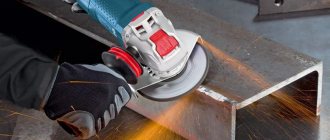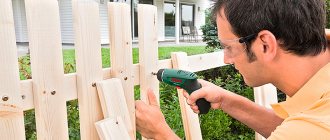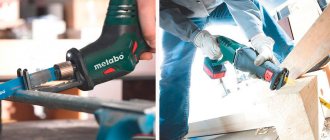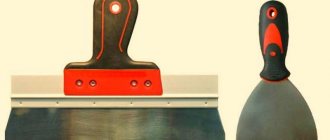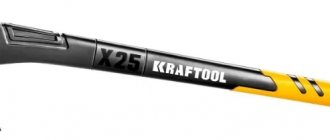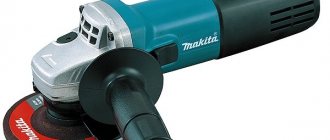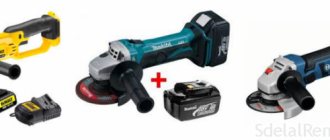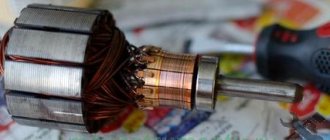What is a grinder used for and what main parts does it consist of?
The correct name for an angle grinder is an angle grinder, but its popular name has taken root in everyday life - “grinder”, because... Angle grinders were massively imported to the USSR from Bulgaria. A grinder is an indispensable tool in the arsenal of any home craftsman, builder constructing a country house, or professional worker engaged in the manufacture or dismantling of metal structures. An angle grinder will be useful to you when performing the following operations:
- Using a grinder, they cut, grind and polish metal - square and round pipes, channels, angles, I-beams, fittings, etc.
- A grinder, if you install special equipment on it - wire brushes, perfectly removes rust or old paint from various surfaces.
- You will need an angle grinder when cutting concrete, brick, ceramic tiles in the kitchen or bathroom, or cutting grooves in stone walls.
- Using an angle grinder, you can brush wood to give the surface an aged look.
- Craftsmen, based on grinders, make cutting machines, which increases the speed, safety and ease of working with the tool.
The grinder consists of two main parts - a plastic body and a durable metal gearbox, where the shaft drive gears are located, which transmits rotation to the equipment. An electric motor is housed in the tool body. On the side of the gearbox or on the main handle, depending on the angle grinder model, there is a button or tool start key. Also on the gearbox there is a button for fixing the grinder drive, which blocks the spindle of the machine, for changing the cutting disc or equipment.
Additionally, on the body of the angle grinder (not on all models), there may be a wheel with which the rotation of the tool is adjusted. We will explain why this is needed below.
Where to start choosing an angle grinder
If you go to any hardware store, your eyes will widen from the abundance of different equipment. Among the angle grinders there are both budget household models and tools designed for professional work, the cost of which is “biting”. How to choose the model that is best suited for you? We offer a simple step-by-step algorithm for choosing an angle grinder.
The key parameters of an angle grinder are the diameter of the disk with which the tool works and the power of the machine. Discs for angle grinders, in turn, come in several diameters:
- 11.5 cm;
- 12.5 cm;
- 15 cm;
- 18 cm;
- 23 cm.
For household and small work, grinders with a disc diameter of 115 or 125 mm are most often purchased, but the most universal diameter is 125 mm. An angle grinder with such a disc is suitable for cutting metal profiles, polishing and grinding various products, cutting ceramic tiles and sheet metal.
The depth of the cut, as well as the width of the gripping surface, depends on the diameter of the grinder disk, which is important when cleaning flat products.
For comparison:
- The cutting depth of an angle grinder with a disc with a diameter of up to 115 mm is only 2.5 - 3 cm.
- The 125th grinder will make a cut 3.5 cm deep.
- The cutting depth of the 150th angle grinder is about 4.5 cm.
- The 180th grinder will cut through concrete to a depth of 5 cm.
- The cutting depth of a grinder with a disk diameter of 230 mm will be 6.5 -7 cm.
When working with a grinder, the abrasive disc is constantly ground down. This leads to a decrease in its diameter, and hence the depth of cut.
A novice master may think that for work he needs to buy the most powerful angle grinder with the maximum disc diameter. After all, it will definitely be enough for the entire scope of work. This is the wrong approach. The grinder is selected strictly for a specific task . You should not try to do heavy work on stone or saw a rail with an angle grinder with a disk with a diameter of 115 - 125 mm.
The scope of application of the 125th grinder is periodic cutting of reinforcement or profile pipes when building a fence from corrugated sheets, cleaning metal from rust and paint, cutting tiles when renovating a bathroom, etc.
If you need to cut thick-walled metal pipes, I-beams, channels, angles, concrete pillars, bricks, make deep grooves in walls or cut an opening in a wall in a stone house, you need a powerful grinder with a maximum cutting depth. Those. a tool with a disk diameter of at least 180 mm, and preferably 230 mm.
The next criterion for choosing an angle grinder is the power of the tool.
Optional equipment
In addition to the standard layout and operation scheme, most manufacturers equip their models with additional functions that increase operational safety and make the tool more practical to use. There are several useful options that you should definitely know about when choosing an angle grinder.
Soft start
Smooth starting of the electric motor solves several problems at once. It provides a truly soft start without the characteristic jerk of the disc. Protects the motor winding from sudden voltage surges and protects the home electrical network from burnout.
The soft start function will be the right choice for professional tools where powerful motors and large diameter discs are installed.
Speed controller
An indispensable option if the grinder will be used to perform various types of work. It's no secret that cutting metal and grinding parts require different spindle speeds. Failure to comply with the speed limit leads to premature wear of the disc, and the speed controller helps prevent this problem.
Automatic disk balancing
This option can only be found on high-quality products from well-known brands. The essence of the trick is that the grinder independently levels out the runout of the disc during uneven abrasion of the abrasive cloth. In particular, the auto-balancing function significantly improves the quality of work performed and cutting accuracy.
It should be added that the benefit of the option can only be felt when working with discs with a diameter of 150 mm or more. The surface of a circle with a smaller radius is usually ground down evenly, so actually balancing will be useless, although it will significantly increase the purchase price.
Disc jam protection
A useful option that significantly increases the operating life of the electric motor. When cutting hard material, the grinder disk may jam, but the motor will still try to turn the spindle, causing the winding to overheat. Thanks to the built-in protection, when the rotor stops, power to the coil stops automatically.
Dust collector
The advantage of this function will be appreciated by professional builders who have to work with various types of building materials. In particular, it is impossible to cut an expanded clay concrete block or lay a groove in a concrete wall without a huge amount of dust.
If we do not take into account the harm caused to health and the aesthetic side of the issue, we can add that the body of the angle grinder is not sealed, so microscopic dust particles that get inside noticeably increase the wear of all rubbing parts. Therefore, the built-in dust removal system prevents premature failure of the power tool.
Quick Release Clamp
These are SDS series nuts that allow you to effortlessly change the disc in just a few seconds. In the standard version, the nut has to be unscrewed with a special wrench, sometimes involving a partner.
What power to choose for an angle grinder
The power of grinders varies, on average, from 600 to 2000 W and above. The most powerful angle grinders at 2.5 - 2.6 kW are machines with a disk diameter of 230 mm, but among angle grinders with a disk diameter of 125 mm, there are models with a power of more than 1 kW.
The higher the power of the grinder, the more productive the tool and the greater the load it will withstand, working without stopping.
The advantage of the grinder’s high power is that the tool can cope with almost any task in a short period of time. The disadvantage of increased power is the heavy weight of the tool and the difficulty of working in hard-to-reach places.
A powerful angle grinder is more difficult to hold in your hands in case of emergency situations - jamming of the disk, kickback. These negative phenomena are effectively combated by additional protection functions that are equipped with the most expensive tools and which we will discuss below.
The choice of a grinder will be simplified by the “cheat sheet” from FORUMHOUSE:
- For most household work, a tool with a power of 700 to 1300 W with a disk diameter of up to 125 mm is suitable. With this grinder you can cut a profile pipe, a corner, and saw off fittings. Clean rusted fence posts before welding with an inverter. Grind stone or cut ceramic tiles and slate sheets.
- For professional use or heavy work, choose an angle grinder with a power of over 1500 W. These are models with a disk with a diameter of 180 - 230 mm. An angle grinder with a disk with a diameter of 150 mm, less running, because in terms of cutting depth they are not far behind the 125 models.
Another important parameter of an angle grinder is the number of revolutions.
- Discs with a diameter of up to 115 mm spin at a speed of 12,000 rpm.
- The rotation speed of discs with a diameter of 125 mm is 11,000 rpm.
- Discs with a diameter of 180 mm rotate at speeds of up to 8500 rpm.
- 230 discs spin at speeds of up to 6500 rpm.
The smaller the diameter of the grinder disk, the higher the speed of its rotation.
What is included in the package of the grinder and what simplifies the operator’s work
The configuration of the grinder depends on its manufacturer and the price of the tool, but several basic elements can be identified. This:
- Protective cover. It protects the operator during operation from sparks, abrasive particles and, in the event of a disc rupture, from debris. The position of the protective casing on simple angle grinders can be changed using a screwdriver or hexagon.
Choose models of sanders with a screwdriverless system for adjusting the position of the protective casing. This saves your time, because... During work, it is often necessary to change the installation angle of the casing.
- Additional side handle. For a number of angle grinder models, the handle can be set not in two, but in three positions: screw it to the left, right or on top of the gearbox and, thereby, flexibly adjust the operator’s grip, depending on the type of work performed.
Professional models of angle grinders are equipped with rubberized anti-vibration handles. This handle effectively dampens vibrations, which increases operator comfort when working with powerful tools and performing heavy work.
- A wrench for tightening and unscrewing the nut that presses the disc to the tool flange.
Expensive models of angle grinders, Bosch GWS 26-230, are equipped with an SDS type quick-clamping nut, which allows you to quickly replace the equipment.
Additional functions that simplify operation and increase the efficiency of working with angle grinders:
- For professional models of angle grinders, the position of the main handle is adjustable, which is also equipped with a vibration reduction system. This handle rotates around its axis 360 degrees. This will allow you to reconfigure the angle grinder to perform a new task in a few seconds.
- Advanced angle grinders are equipped with an auto-balancing function for the disc, which also reduces the vibration of the tool, but increases its price.
For most users of grinders, it will be enough if the tool is equipped with an anti-vibration handle. You shouldn’t overpay for balancing and other bells and whistles unless you plan to work with an angle grinder for 6-8 hours a day.
For some powerful angle grinders, manufacturers make a closed main handle. This handle allows you to securely hold the sander. This is especially important if an emergency situation occurs during work - a kickback - a sharp locking of the spindle.
The closed handle rests on the operator’s hand and the tool will not break out of the hands.
Note! The grinder's gearbox can be rotated relative to the body. This design feature will be required if you have to work in hard-to-reach places or if the operator is right-handed or left-handed.
What is rotation speed adjustment, how does it work, is it needed and why?
In the simplest version, the rotation speed can be changed using a power control device, which is based on the principle of variable resistance . That is, by and large it is an ordinary rheostat . Many users use it on household grinders when carrying out polishing and grinding work with soft materials, where at low speeds they can achieve high-quality results.
Typical electrical circuit diagram of the speed controller. Photo source here
However , the use of such a device increases the risk of the angle grinder overheating , as overloads occur at low speeds. For this reason, the feasibility of equipping household angle grinders with a power regulator is highly questionable.
Professional, powerful angle grinders are equipped with a more complex technical device for adjusting speed, which is based on an electronic circuit . The presence of a function to support rotation speed when the load changes is its distinctive feature. The prices for such grinders are much higher than for ordinary household ones.
Useful video
With feedback
The system for maintaining the speed of professional angle grinders during regulation includes a sensor that reads the rotation speed . The magnet included in the sensor design sends a signal to an electronic control device, which reports data on the rotation speed. The electronic unit reacts accordingly, increasing the current in the electric drive windings as the load increases (reduces speed). This feedback from the tachometer and the electronic unit occurs continuously and maintains a stable rotation speed in different operating modes of the angle grinder.
What functions and systems are modern angle grinders equipped with?
Some models of sanders have a function for adjusting disc rotation speed, from 2800 to 11000 rpm. Using the speed control function, you can select the optimal rotation speed of the equipment, depending on the type of work.
For grinding metal or brushing wood 11000 – 12000 rpm. are redundant, therefore, the user, by rotating the speed controller, sets the mode he needs, and then also smoothly increases the speed if he proceeds to cutting metal.
The grinder is one of the most dangerous household electrical tools. Therefore, manufacturers equip a number of angle grinder models with special functions:
- Locking the start button will prevent the tool from being accidentally turned on when the user is not working with it.
- Protection against unintentional restarting of the angle grinder is useful if there is an accidental power outage. The instrument will not turn on spontaneously when power is restored, even if the trigger button is pressed.
- Anti-jam protection instantly stops the tool's motor.
This system will protect the operator from kickback if the blade is suddenly pinched while sawing a metal pipe.
- Dust protection. Protection of the tool from small abrasive particles, dust, grains of sand, etc. This system will extend the life of the angle grinder if it is used for work involving sawing or grinding stone and stripping metal. It includes a labyrinth seal and filling the motor winding with a special resin.
If you are going to cut or grind concrete, brick, or tiles with a grinder, make sure that the description of the tools says “for working on stone” or “has dust protection.”
- Overload protection will protect the tool from overheating and will turn it off if excessive force is applied, which threatens to damage the angle grinder.
They also put useful electronics on the grinder:
- Soft start – gradual increase in disk speed. This reduces the load on the network when starting the tool and extends the life of the gearbox, because there is no starting jerk when the angle grinder engine suddenly gains speed.
- System for maintaining constant speed under load . This feature prevents the blade from slowing down during heavy-duty work such as cutting concrete or grinding metal products.
Tools
0 votes
+
Vote for!
—
Vote against!
The second most important tool after a drill is an angle grinder (angle grinder), commonly known as an angle grinder. This name was assigned to the unit back in Soviet times, when Bulgaria was the first and only supplier of angle grinders. Today you can buy grinders from various manufacturers, both European, American and Japanese. The choice is so great that as soon as we come to a hardware store, we immediately face the question of how to choose an angle grinder - an angle grinder, and what parameters to pay attention to. After all, with the help of it we cut almost everything that needs to be cut. These are metal, brick, concrete, cement, ceramic tiles, plastic, wood, porcelain, stone, asphalt, glass. But this unit is designed not only for cutting, but also for grinding various surfaces. Therefore, when choosing, you need to determine which additional functionality or design features are really needed, and which you can do without.
- Main characteristics of angle grinders
- Grinder disc diameter
- Grinder power
- Disc rotation speed on an angle grinder
- Additional structural elements or features of grinders
- Ease of use
- Safety
- Additional options
Main characteristics of angle grinders
When you come to a construction supermarket, a specialized tool store, or just to the market to buy an angle grinder, the first question you will be asked is whether you need a professional tool or for yourself. Professional angle grinders are designed for daily use for several hours a day. To make the work of the master easier and to extend the life of the unit, it is equipped with enhanced dust protection, all kinds of electronics, design features that reduce noise levels, and adjustable disk rotation speed.
The grinder “for yourself” belongs to the category of a household tool for a home craftsman, who will use it occasionally, when suddenly something breaks or needs to be done, or no more than 30 - 40 minutes a day. Household angle grinders have less power and require working intermittently. For example, 15 – 20 minutes of work and 30 minutes of rest. During this time, the engine has time to cool down and the likelihood of failure is less.
When choosing an angle grinder for home repairs or professional work, you need to understand exactly what specific work it will be used for. Based on the needs, the diameter of the disk, its rotation speed and the power of the grinder are selected.
Grinder disc diameter
The diameter of the angle grinder disk is the main parameter that you need to focus on when choosing; the power of the unit and the rotation speed of the wheel are selected taking into account the diameter.
There are grinders for discs with a diameter of 115 mm, 125 mm, 150 mm, 180 mm, 230 mm. The simplest angle grinders with a disk diameter of 115 - 125 mm are household ones; they can be used for grinding various surfaces, removing rust and paint from parts, for polishing, as well as for cutting various metals and ceramic and granite tiles, the thickness of which does not exceed 50 mm. The main limitation when cutting is the thickness of the material. A small diameter disc will not cut a concrete curb or other massive element. But for home needs, a 125 mm grinder is more than enough.
230 angle grinder belongs to a professional tool, and the 180 mm one can also be included in the same category. Such powerful units are used for cutting massive concrete products, asphalt, stone, and brick. Enormous power, a heavy massive disk, and large vibrations make it pointless to use a grinder with a disk diameter of 230 mm for cutting thin corners, sheet iron, tiles, plastic, as well as for grinding and polishing surfaces. This is easier to do with a less powerful and weighty unit.
Grinder power
The range of power in angle grinders is very large: from 600 W to 2700 W. Grinders with a 115 mm disc come with 600 - 1000 W of power, more is simply pointless.
Grinders with a 125 mm disc have a power of 750 - 1500 W. As a rule, low-power units from the 125 mm series have a small number of additional functions and are not intended for long-term use. Grinders with a power of 1200 - 1500 W are usually stuffed with all sorts of useful functions and elements.
Grinders with a circle of 180 - 230 mm belong to multi-power units 1500 - 2700 W. To cut concrete, stone and other massive elements you will need an angle grinder with a power of 2000 W or more. But for cutting small parts, sheet metal, plastic, for grinding and polishing, an angle grinder with a power of 720 - 1000 W is suitable. If you buy an angle grinder for home repairs, but for complex work, then it is better to take a 125 mm angle grinder with a power of 1200 - 1500 W.
The more power an angle grinder has, the longer it can work under load. The power is selected taking into account the complexity and duration of the work, and the weight of the disk you are going to use. For example, if you plan to clean a weld seam with a 115 mm grinder, then you need to take a unit with a power of 1000 W or more. If you plan to use heavy 230 mm disks, which are not so easy to spin, then the power will need from 2000 W.
Disc rotation speed on an angle grinder
The rotation speed of the disk or spindle on which it is mounted indicates how many revolutions per minute it makes. The larger the drive is installed, the lower the speed required.
The rotation speed of the disk on an angle grinder ranges from 2800 rpm to 11000 rpm. Small circles 115 - 125 mm are used at a maximum speed of 10 - 11 thousand rpm. But for 180 mm wheels there is already a limit of 8500 rpm, and for 230 mm wheels – 6650 rpm. These restrictions are due to the fact that the linear speed of the cutting edge of the disk should not exceed 80 m/s, otherwise the disk may fly apart, injuring the master.
Important! It is better to purchase an angle grinder that has the ability to adjust the rotation speed of the disc depending on the size of the disc being used. Most often it is implemented using a special lever or regulator.
Let us remind you that the disk size indicated on the label is the maximum allowable. For example, a 150 mm grinder can accommodate 115, 125 and 150 mm discs.
Additional structural elements or features of grinders
Modern units are very different from the first models of angle grinders; they have become more reliable, versatile, durable and functional, with a wide range of capabilities and elements that make work easier. For ease of choice, we will divide the functionality of the grinder into 3 categories.
Ease of use
Ease of use includes not only those innovations that simplify working with an angle grinder, but also make it more durable, and the process itself smoother and more coordinated.
The anti-vibration handle is an extremely important element. Vibrations are very harmful to human health. If you work with an angle grinder for several hours a day, you can get an occupational disease. In addition, even during short-term operation, vibrations can weaken your hand grip, the grinder will jump out and there will be trouble. To reduce vibrations, vibration-absorbing handles are installed in professional tools, which absorb vibrations, making work less tiring and difficult. Almost any Bosch angle grinder over $175 can boast an anti-vibration handle.
The anti-vibration system is also designed to dampen vibrations, just like the anti-vibration handle. Its main task is to reduce vibrations to such an extent as to extend the ability to use the grinder without interruption. For example, if the norm is 26 minutes, then the anti-vibration system allows you to work for 42 minutes. Most often, this system is implemented using counterweights.
Protection from dust and noise . Protection from noise is important primarily for the master, since constant rumbling sounds can lead to temporary deafness. If the master works with an angle grinder every day, you can only sympathize with him or advise him to use earplugs or headphones. Directly in the angle grinder itself, helical gears (Glisson pair) are used to reduce noise; their engagement is more reliable and they operate quieter.
But dust protection is important to ensure the longevity of the tool. If dust settles on an idle unit, it does not cause any harm. If it gets into a mechanism that is spinning at breakneck speed, it performs a destructive function, since it is an abrasive material. First of all, you need to protect the engine. To do this, the winding is coated with special resins, which after hardening serve as armor. A slightly different method is a filtration system that releases dust particles back into the atmosphere. In addition to the engine, manufacturers also protect other elements. For example, the Makita angle grinder hides gears and bearings behind special labyrinths that slow down the dust jet.
The spindle lock is needed to make it easy to replace the disk. This feature is found in almost all modern models. By pressing the button the driven gear is locked. It’s just that this is implemented in different ways. Ideally, you can lock the spindle in any position, but this is extremely rare; most often you have to rotate the disk by hand until you catch the moment.
Important! You cannot press this button until the disk stops completely.
Although there are also exceptions to this rule, which are dictated by the mechanism itself. A striking example of this is the Metabo angle grinder. In it, the mechanism acts on the clutch connected to the driven gear, and not on the gear itself. Therefore, the button can be pressed immediately after turning off the angle grinder, i.e. on the run-out.
The disc is secured without a key using a special nut that comes with the grinder. The design of the nut itself is very interesting; it consists of several parts. When the nut is screwed onto the spindle and its bottom rests against the circle, then only the upper part of the nut rotates further, and the lower part presses the circle harder and harder. After prolonged use, such a nut self-tightens, and it is no longer possible to unscrew it with your fingers. You still have to use the keys. Although there are manufacturers who have successfully improved the clamping mechanism. For example, the DeWALT angle grinder boasts a nut that can be easily unscrewed even after long, hard work.
Adjustment of the protective cover without a key is carried out using special clamping mechanisms. A very important feature for those cases where it is necessary to frequently change the position of the casing. The clamp and lever, which can be tightened, allow you to fix the casing in any position. This method has a significant drawback - due to strong vibrations, the clamp can collapse, and the casing will rotate around its axis loose. There are also more advanced mechanisms, but they are found on expensive professional equipment.
A protective casing for an angle grinder is necessary for the convenience of the master during grinding work. It protects it from fragments of the material being processed, as well as in the event of destruction of the disk from its particles. The casing does not interfere with processing corners and edges; for this purpose it has a sliding section. To remove dust from the treated area, a vacuum cleaner can be connected to the protective casing.
Safety
In addition to the features that affect the convenience of working with an angle grinder, there are additional elements, functions and features that ensure safe operation for both the operator and the unit.
The number of handles - one or two, is a matter of convenience for each master. Most angle grinders with discs up to 150 mm are equipped with only one connected handle near the spindle itself. But this does not mean that the grinder can be held with one hand; this is strictly prohibited. The other hand must hold the motor housing. In heavier angle grinders, there is another handle behind the engine housing, which is like a continuation of the body, but at the same time more convenient to grip. What the second handle looks like can be clearly seen in the photo, which shows a Makita angle grinder.
Smooth start prevents the starting jerk of the disk and also protects the gears from excessive wear. All modern grinders are equipped with a similar feature: both household and professional. A smooth start is especially important if the angle grinder is of high power. It can be implemented in different ways. There are models in which the spindle picks up speed in a few seconds; for an impatient master, this risks the fact that he can load the unit before reaching maximum speed. In other models, the spindle picks up speed almost immediately, but there is no jerk at the start. You can check this only by turning on the angle grinder in the store.
Restart protection is necessary so that after a sudden shutdown and then switching on of the power, the angle grinder does not start working. Usually, if the power supply suddenly stops, we put the tool aside and go check what happened. If at this moment the supply is restored, the engine will start and the wheel will begin to rotate straight in the lying position. There is no need to explain how this could end. And so it will be necessary to first move the power lever to the “off” position, and then again to the “on” position in order to start the angle grinder.
Direct engine cooling allows all system elements to be cooled sequentially. It’s no secret that during operation the angle grinder heats up, especially the gearbox housing. The ventilation system and special lubricants do not completely solve the problem, although they are an effective help. How this is implemented is shown in the photo of a Bosch angle grinder. For rapid cooling, the gear housing is made of metal, most often aluminum or magnesium alloy. It cools faster and is stronger than plastic. And in some models, for example, in the Hitachi angle grinder, even the motor housing is completely cast from metal.
A starting current limiter is necessary to reduce the load on the network when the engine starts. This feature is relevant only for powerful models of angle grinders. “Soft start” smoothes out voltage surges in the network, thereby preventing overloads.
The safety clutch is necessary in order to prevent the destruction of the disk when jammed and to smooth out the return blow. This will protect the motor from overload. It is implemented in different ways: in some models it is a slip clutch, which reduces the load on the engine, in others it is a centrifugal clutch, and in others it is a completely different patented system, reminiscent of the clutch in a car gearbox, completely disconnecting the engine and the gearbox.
The emergency engine stop system when the disk is jammed is a more advanced safety system than the clutch and is found in more expensive professional models. The electronic stop system instantly shuts down the engine when a disc becomes jammed or jammed. The Bosch angle grinder boasts both an electronic engine stop system, Kick Back Stop, and restart protection.
An overvoltage fuse or thermal motor overload protection represents a whole range of measures. Most often, overload is recognized by the engine temperature. For example, when the temperature of the windings reaches 130 °C, the light comes on, when it rises to 160 °C, the speed decreases, and at 200 °C the grinder switches off completely. This protection system may irritate those who like to load the instrument heavily and for a long time.
Additional options
Angle grinders may also have additional options, features or elements that make the job easier or affect ease of use.
Electronic stabilization is necessary to maintain a certain speed under load. During operation under load, the speed begins to fall, and the current strength, on the contrary, increases, so that the efficiency of the unit does not fall, the electronics connects an additional reserve, again increasing the speed. Remember that you should not overload the tool. Do not press it if you see that the disc may jam.
The rotation speed of the disk is adjusted using a wheel on the body of the angle grinder. As we already wrote, it is adjustable depending on the diameter of the disk used. Please note that it is easier to damage the tool at low speeds than at high speeds. Although you won’t be able to do without low speeds if you want, for example, to sand plastic or remove paintwork. Please note that not all economy class models are equipped with this function. For example, the Interskol angle grinder has an adjustment wheel, starting with units costing from 70 USD.
The disc brake reduces the run-down time to 3 seconds. This is a help for the impatient. It can be implemented in different ways. For example, in Metabo angle grinders it is similar to a regular brake in a car and operates on the principle of friction. Bosch angle grinders have a more complex electronic system that works on the principle of polarity reversal. But keep in mind that the second method is only possible if the unit is connected to the mains. When the power is turned off, the disk stops according to the standard scheme.
Automatic disk balancing is very rare, but it makes the job more enjoyable. A special clutch, in which the balls are immersed in oil and are grouped depending on the displacement of the center of gravity, significantly reduces the vibration of the disc. This allows you to slow down the wear of the disk itself and reduce vibration during operation.
The removable network cable is convenient in all respects. Firstly, you don’t have to think about what and how to wrap it around in order to hide it or move it to another place. Secondly, in case of damage, you can simply get a spare tire or buy a new one. In all respects, the detachable cable makes it easy to transport the instrument. But it is found only in some models of Protool, Kress and Milwaukee angle grinders.
Easy access to replacement brushes allows you to replace them without going to the service center. There is a special plug on the body of the tool, removing which you get full access to the brushes.
Self-switching brushes allow you to extend the service life of the grinder. In the event of a sudden power outage, a sharp surge in voltage occurs. To prevent the engine from burning out, it must turn off immediately. Many units above the average cost can boast of this function, including the Sparky angle grinder made in Bulgaria.
Convenient switch . The grinder's power button itself should be as convenient as possible for the master and durable. For example, levers and wheels do not last long. And a convenient slide switch, no less than the width of a master’s finger, will serve for a long time and reliably. Found in many models, including the Russian-made Caliber angle grinder. By the way, grinders from this manufacturer belong to the economy category and are very cheap. The most expensive and sophisticated models are no more expensive than 80 USD.
A suitcase for transportation and storage is a nice bonus to a high-quality unit.
The choice of angle grinder manufacturer is also very important. Russian-made grinders are surprisingly cheap, but do not have a number of additional protection measures or functions, although they are reliable and durable. Chinese-made grinders can only be bought if you plan to do some work and then throw the unit in a landfill. European-made angle grinders Bosch, Sparky, Metabo are distinguished by their quality, durability and strength of parts. Just pay attention that the product was manufactured in Europe or Eastern Europe, for example, in Romania. Analogues from China are of very dubious quality. Japanese-made grinders Hitachi and Makita will delight their owner with the reliability, solidity and indestructibility inherent in Japanese technology.
Why do you need a battery-powered angle grinder?
Light weight cordless angle grinders should be placed in a special category. These models are not very common among ordinary craftsmen and are not often purchased. The reasons are high cost, low power and they are not suitable for long-term continuous operation.
Let us leave outside the scope of this article expensive professional models of angle grinders that are used in industrial production or construction. For the average home craftsman, an angle grinder with a battery will come in handy if you need to do minor work in an area where there is no electricity. Or you need to saw off several fittings or cut a water pipe. In all other cases, cordless angle grinders are inferior to networked models and you need to think ten times before buying such a tool.
For example: a Metabo WB 18 LTX BL 125 Quick grinder with a disk size of 125 mm, a supply voltage of 18 V, two Li-Ion batteries with a capacity of 8 Ah costs more than 30 thousand rubles.
How weight affects the ease of working with an angle grinder, and what equipment is available
Powerful grinders for a disc with a diameter of 230 mm have a large weight of 5 - 6 kg, and if you add the mass of equipment and a carrying case, the total weight of the tool will be about 8 kg. Working with such an angle grinder is physically more difficult, because the operator gets tired faster.
Low power models weigh less. The Makita GA5030 model, popular among craftsmen, weighs only 1.4 kg. You can work with such an angle grinder even with one hand. This is especially important if you need to crawl into an awkward, tight place for light work and need to saw something off.
Equipment for grinders includes:
- Abrasive wheels for cutting and grinding metal.
- Diamond wheels for working on stone, concrete, brick.
- Diamond cups for grinding stone.
- Special casings for working with diamond cups. The casing can be equipped with an adapter for connecting a construction vacuum cleaner or a cyclone.
- Cord brushes, wire brushes for cleaning products from rust or old paint.
When choosing an angle grinder, you must clearly understand what kind of work you are buying it for. The parameters of the grinder, disc diameter, power, necessary equipment and the final price depend on this.
Household angle grinder Makita GA5030
The Makita grinder with speed control is considered one of the best models of household angle grinders. Its price is 2500 rubles. The Makita GA5030 is lightweight, not exceeding 1.8 kg, which is an advantage of this tool compared to other similar models in this price category.
The design of the grinder is characterized by high build quality and is equipped with a speed control function, which allows you to use the GA5030 Makita for any type of work: cutting, grinding and polishing. Numerous positive consumer reviews indicate that the Makita GA5030 model has low vibration during operation, and the additional handle included with the tool greatly facilitates the operation process. Despite all the advantages of an angle grinder, its owner should remember that this angle grinder (angle grinder) belongs to the category of household angle grinders, which means that breaks should be taken periodically while working.
Tips for working with an angle grinder
Beginner users always have many questions about working with an angle grinder. Feel free to ask them to experienced users of our portal, because... This will make it easier to get to know the instrument and will keep you healthy.
MargodontFORUMHOUSE user
I bought myself a grinder and started working with an angle grinder. Before this, I read many articles and searched through a lot of information on the Internet on safety precautions for operating an angle grinder. Have questions:
- How to cut with a grinder - with sparks towards yourself or away from you? Everywhere they write differently.
- How to choose the right blade thickness for cutting metal? Some say that thin sheets require a thick disk, others say the opposite.
- Tell me, what kind of disk to cut sheet metal with, what thickness is needed depending on the thickness of the metal?
I once tried to cut a stud with a diameter of 8 mm with a disk 2.5 mm thick. Did not like. It's slow, it takes a lot of time, and I'm afraid to install a thinner disc. Suddenly it will fly apart.
Why did such discrepancies arise and how to cut metal correctly and with what discs?
BehemothForumHouse user
For safety reasons, when cutting with a grinder, sparks should be directed towards yourself. Let sparks happen under your feet, not on your clothes. Do not stand on the cutting line of the rotating blade. For cutting sheet metal, I would take a 2.5 mm thick disk, in case it gets bitten, it will not fly apart. For cutting studs, reinforcement and other metal, I recommend working with a cutting disc with a thickness of 1, 1.2, 1.6 mm.
OldyshamForumHouse User
I have been working professionally with angle grinders since 1995. I let off sparks from myself. I’m right-handed, it’s more convenient for me to work this way because I can see the cutting line and sparks don’t fly onto my clothes. The grinder, as it were, crawls onto the cutting line of the workpiece. For myself, I have formulated several basic rules for working safely with an angle grinder:
- The most important thing is reliable eye protection. Don't buy cheap plexiglass glasses. Buy branded eye protection glasses from a trusted brand. Yes, they are expensive, but if you damage your eyes with abrasives or metal shavings, you will not be able to buy them for any money.
- Watch where the sparks fly. If people are standing nearby, let them move away. There should be no flammable liquids, dry grass, leaves or rags soaked in gasoline or motor oil in the area where sparks fall.
- Try to cut in such a way that the workpiece being cut can fall without pinching the disc. Calculate in advance how the grinder disk will go so that it does not jam.
- Hot sparks, if they hit glass, glazed ceramic tiles, car paint or high-gloss finishes, will damage these surfaces.
- Start mastering the grinder with cutting discs 2.5 mm thick. Leave discs with a thickness of 1 - 1.2 mm for later, when you work more confidently.
You can cut with a grinder using sparks towards yourself or away from you, as is more convenient for you.
Follow the rule : if you are cutting metal with sparks towards you, cut into the workpiece from the edge that is closest to you. If you cut with sparks from yourself, then start the cut from the edge of the workpiece farthest from you and, as it were, pull the tool towards you.
If you are just going to buy an angle grinder, choose a medium-priced model with a disk diameter of 125 mm and a power of 0.7 to 1 kW. Don’t chase the top and best brands of grinders. For the first acquaintance with an angle grinder, it is better to buy a domestic machine, select cheaper manufacturers, whose quality is confirmed by real user reviews. Once you get your hands on it, you will understand whether you need a more powerful and expensive grinder, with a disc diameter of 230 mm, the operation of which requires a higher qualification from the operator.
